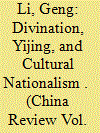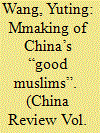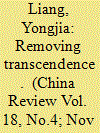|
|
|
Sort Order |
|
|
|
Items / Page
|
|
|
|
|
|
|
| Srl | Item |
| 1 |
ID:
162846


|
|
|
|
|
| Summary/Abstract |
One feature of Chinese Catholicism, as identi�ed by o�cial Chinese
investigation, is that most Chinese Catholics belong to traditional
Catholic families and communities, which include generations of
believers. �is is a relatively stable religious population, whose growth
depends largely on the continuity of the family and the community. To
explore the origins of this legacy, this article studies the formation and
early development of Chinese Catholic communities in Northeast
China and their models of religious governance. It argues that the widespread Catholic missions since the 19th century diffused not only
religion but also notions of autonomy and models of local governance
among Chinese Christians. Based on archival research and �eldwork,
the article focuses on two Catholic communities in Northeast China.
�ese two cases demonstrate that the early development of Northeast
Catholic communities was largely due to immigration and the absence
of the state. �e growth of the community coincided with the formation
|
|
|
|
|
|
|
|
|
|
|
|
|
|
|
|
| 2 |
ID:
162841


|
|
|
| 3 |
ID:
162844


|
|
|
|
|
| Summary/Abstract |
By aligning themselves with the Book of Changes (易經 Yijing) and
National Learning (國學 Guoxue), diviners in contemporary China
regard themselves as protectors of “traditional culture” and promoters
of “China’s national wisdom.” �e alignment with the national tradition not only enhances divination’s social status, but also generates
more pro�t for diviners and constructs a limited a�nity with o�cial
ideology. Diviners can shi� their public image from being typical
representatives of backward feudal superstition to being in the
vanguard of a traditional culture that is essential to China’s national
identity. All of this is occurring against the background of China’s
national project of global reordering and promoting cultural nationalism. The reactivation of elements of the cultural patrimony is
regarded as useful to legitimize state power and to fortify national
cohesion. While popular religious practices o�en maintain an alternative view to that of the state, they also develop connections with hegemonic discourses, dynamically and strategically.
|
|
|
|
|
|
|
|
|
|
|
|
|
|
|
|
| 4 |
ID:
162843


|
|
|
|
|
| Summary/Abstract |
�is article examines how doctrinal innovation led to the politicization of Falun Gong, a new religion in China. A�er it was outlawed in
1999, Hongzhi Li (李洪志), the charismatic leader of Falun Gong,
developed a theory of resistance focusing on the strategy of “Clarifying
the Truth.” Guided and justified by the theory, FLG practitioners
engaged themselves into various forms of collective activities against
the Chinese government. �e theory also helped Li to mobilize social resources overseas. Most importantly, the process of doctrinal
innovation enabled Li to interact with his followers frequently
and thus keep his charismatic authority in the group. In sum, the
formulation of the “truth” theory not only led to FLG’s politicization but also sustained the group’s vitality by means of justifying the resistance, mobilizing social resources, and maintaining
Li’s charisma.
|
|
|
|
|
|
|
|
|
|
|
|
|
|
|
|
| 5 |
ID:
162842


|
|
|
|
|
| Summary/Abstract |
Lay Buddhism is situated at the center of intersecting power relationships between politics and religion, and between sangha and laity. �e
understanding of its evolution is fundamental to explore the logic of
the recomposition of the whole Buddhist landscape in contemporary
China. Based on historical materials and fieldwork, this article
examines the organizational form, social participation, and political
space of lay Buddhism over the past century. In the �rst half of the
20th century, new intellectual and economic elite Buddhists renewed
their mobilization modalities, deeming their participation in the
building of the Chinese modern state and society as an accumulation
of religious merits. A�er 1949, under the policy of state corporatism
that aims to control and use sangha Buddhism, lay Buddhism was
extremely marginalized. �is lasted long following the 1980s. In the
ongoing Buddhist revival, lay Buddhism has much less political power
for development than sangha Buddhism, since the post-Mao
|
|
|
|
|
|
|
|
|
|
|
|
|
|
|
|
| 6 |
ID:
162847


|
|
|
|
|
| Summary/Abstract |
Driven by the need to survive in a predominately non-Muslim society,
Chinese Muslims, or the Chinese-speaking Hui people, have traditionally played the role of a middleman minority. During the last few
decades, benefiting from the strengthening economic ties between
China and the Arab world, especially the Arabian Gulf countries, Hui
Muslims have gained greater visibility and relevance in Sino-Arab relations. Enabled by their dual identity, Hui Muslims have evolved from a
middleman minority that exists on the margin to cultural brokers who
are increasingly central in China’s Belt and Road Initiative. Drawing on
a multiyear ethnographic study of overseas Chinese in Dubai—the most
important trade hub and a rising global city in the Arab world, this
article shows that through actively utilizing religious and cultural
capital, Hui Muslims in Dubai play the role of trusted mediators
between diverse Chinese interests and the Arab Muslim elites and have
|
|
|
|
|
|
|
|
|
|
|
|
|
|
|
|
| 7 |
ID:
162845


|
|
|
|
|
| Summary/Abstract |
The article analyzes primary sources about regulating Catholic and
Protestant communities in Dali, Southwest China, during the heyday of
the People’s Republic. It was a process of sophisticated containment,
in�ltration, spying, and coercion, with a corresponding restrained use
of violence. �is is surprising given that, �rst, both Catholic and Protestant communities were small and, second, that violence against other
potential threats—counterrevolutionaries and landlords—was severe. I
suggest the goal for the local Department of United Front ( 統戰部
tongzhan bu) was not to eradicate Christianity by force but to divide the
church into those who would submit themselves to the communist
utopia and isolate the hard-core devotees with the expectation that both
would eventually die out without “contaminating” the emerging
socialist subjects. �e regulatory process was one in which the state
power attempted to remove the Christian transcendence with a communist one. �e article challenges the state-society dichotomy underlying
the study of Chinese religiosity, especially the claim of “militant
atheism,” which depicts the People’s Republic of China’s early policy on
Christianity.
|
|
|
|
|
|
|
|
|
|
|
|
|
|
|
|
|
|
|
|
|